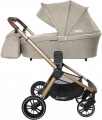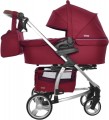Foldable carrycot
Pushchairs in which the carrycot has a foldable design. This feature simplifies the storage and transportation of the stroller, when folded, the
foldable carrycot takes up much less space.
Fastening in the direction/against the movement
In strollers with this function, the seat unit can be fixed in one of
two positions, to choose from: facing the parent (against the direction of movement) or facing away from the parent (in the direction of movement). Each option has its advantages: in the first case, the baby can see a familiar face and is less nervous, and when located in the direction of movement, it is more convenient for him/her to view the world around him/her.
Viewing window
A window made of transparent or translucent material, built into the hood that covers the cradle or seating unit. In the version with a walking block,
the viewing window is usually located so that the parent can see the baby directly while moving, without being distracted from controlling the stroller. In cradles, the parent can see the child through a window by approaching the stroller from the side of the hood (that is, on the opposite side of the handle); implementations with a window in the front hemisphere of the hood are less common. In addition, a baby lying in a cradle can usually see the outside world through the window (primarily the sky above the stroller). The viewing window can be made in the form of oilcloth or a mesh mosquito net, through the holes of which air freely penetrates, but insects and small debris raised by the wind are retained.
Car seat installation
The possibility
of installing a child car seat on the chassis of the stroller. This feature can be very useful on car trips: the car seat can be used both in the car and as a seat unit for a stroller, and the main seat unit can be left at home so that it does not take up space in the boot. Note that some models with this function are initially equipped with a suitable car seat; if it is purchased separately, you should pay special attention to compatibility with your stroller.
Handle height adjustment
Possibility
to adjust the stroller handle in height. This function allows you to optimally adjust the length of the handle to the height of the parent. It will be especially useful if the parents are of different heights, and each of them regularly carries a stroller.
Typically, height adjustment is carried out by lowering or raising the upper segment of the handle, and in advanced implementations
a telescopic mechanism is responsible for it. The retractable handle makes the stroller more adaptable to different situations and conditions. For example, it can be lengthened for more comfortable walking or shortened for ease of use in tight spaces.
Rear wheels without axle
Pushchairs in which the rear wheels are mounted on completely separate stands, without any additional bridge between them.
The main advantage
of rear wheels without an axle is that the legs of the parent following the stroller do not touch the bridge between the wheels. In addition, this feature slightly increases the mobility (allows the stroller to pass between the wheels lying on the road objects, without clinging to them with the axle).
Wheels
The type of wheels installed on the pushchair.
The most popular in our time are
rubber wheels, including
air-filled ones.
Plastic wheels are used mainly in inexpensive pushchairs to further reduce the cost, while
gel ones, on the contrary, are considered a very advanced option.
Polyurethane wheels and
EVA foam-filled wheels are also widely used. Here is a more detailed description of each of these varieties:
— Rubber. Rubber solid tires, found in many modern pushchairs, are popular due to their affordability, quiet operation, and smooth ride over bumps. While less effective on uneven surfaces compared to air-filled and gel wheels, solid rubber tires are cost-effective, low-maintenance, damage-resistant, and suitable for various wheel diameters, including small ones.
— Air-filled. Air-filled rubber tires, commonly featured on pushchairs, offer a softer ride and facilitate easy maneuvering on uneven surfaces and high curbs. Despite their higher cost, they require periodic maintenance to ensure proper pressure and protection against cuts or punctures. However, users find air-filled wheels manageable, as they are thick and less prone to damage.
— Plastic. Plastic wheels, commonly featuring both tire and rim made from this material (thou
...gh some have metal rims), are known for their simplicity and affordability. However, they lack durability, reliability, and effective vibration dampening due to their hardness. Typically found in low-cost pushchairs with small wheels designed for flat surfaces.
— Gel. Wheels similar in design to air-filled tires (see the relevant paragraph), but filled not with air, but with a special gel. The main advantage of this option is its insensitivity to small punctures and cuts: coming out, the gel in the tire in contact with air almost instantly solidifies, effectively sealing the damage. In addition, such wheels are virtually maintenance-free — they do not need to be inflated. The disadvantages of gel tires include high cost and somewhat higher rigidity than air-filled tires (although in terms of softness of running such wheels are still noticeably superior to rubber and even more so to plastic ones).
— Polyurethane. Solid polyurethane tires offer excellent maneuverability, shock absorption, puncture resistance, and durability. They are unaffected by extreme temperature changes and are cost-effective, making them a common choice for various pushchair types.
— EVA. Wheels made of microporous foam rubber, specifically EVA material, offer high elasticity, excellent cushioning, and wear resistance. Lightweight and puncture-resistant, these wheels provide a smooth pushchair ride. However, they may stiffen in cold winter weather.Front wheels diameter
The diameter of the front wheels installed in the stroller.
At the same time, the front wheels are not as important for mobility as the rear wheels: for example, to overcome obstacles, the stroller is often lifted "on its toes" by tilting it towards itself, with only the rear wheels working. Therefore, the diameter of the front wheels may be noticeably smaller than the rear wheels. It should be noted here that the small size also has its advantages — the wheels are lighter.
Speaking of specific numbers, diameter
up to 15 cm is considered very modest,
16 — 20 cm — small,
21 — 25 cm — medium,
26 — 30 cm is larger than average and
more than 30 cm is large.
Rear wheels diameter
The diameter of the rear wheels installed in the stroller.
The larger the wheel — the better it overcomes obstacles and bumps, the more convenient it is to drive the stroller over mud, snow and other difficult surfaces. For the rear wheels these moments are most relevant: for example, when driving the stroller over obstacles, it is usually tilted towards itself, so that the front wheels are in the air, and the rear wheels have to overcome the obstacle. On the other hand, small wheels weigh less and are easier to move, they are better suited for flat surfaces. So choose a stroller on this indicator should take into account the roads on which it has to be driven. If you plan to move on flat floors, good asphalt and stroller ramps — it is worth choosing small wheels, up to 20 cm. For difficult terrain, driving on mud and snow, regular overcoming steps and curbs it makes sense to pay attention to wheels in 30 cm and larger. And the diameter of 20 — 30 cm is an average option — it is suitable if you have to ride mainly on flat surfaces, but occasionally there is a need to overcome obstacles.

